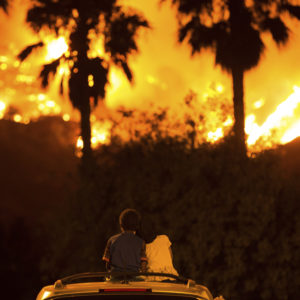Another summer, another fire. At least that’s the way it seems in California, where two smaller fires combined to form the Mendocino Complex on Tuesday. The Mendocino Complex is now the largest blaze in state history. The previous record-setting blaze was a mere eight months ago. Earlier this week, state officials reported that more than 290,000 acres had burned and firefighters warned that it would likely take a month or more to fully contain the blaze. Both the fire and its timing–coming less than a year after deadly fires in Napa Valley–has led some to question the wisdom of construction in fire-prone areas. While changing building codes may help keep houses out of harm’s way, other state policies make it more difficult to prevent and fight California wildfires.
“We have to re-examine the way we manage our forests, the way we build our houses—how we build them, where we build them—and how much we invest in our fire protection services,” California Gov. Jerry Brown said over the weekend when touring the damage.
However, reform will likely take more than just shifts in building policy. Increasing, studies are showing that California’s environmental regulations helped to create the conditions for massive forest fires, while leaving firefighters under-equipped to fight them. To start, forest management policies for decades prevented small scale fires. Now the build up of dead wood has reached an unhealthy level, say oversight groups, providing fuel for what inevitably become massive wildfires.
The Little Hoover Commission, an independent state oversight agency, released a report earlier this year urging the state to reconsider its firefighting policies.
“A century of mismanaging Sierra Nevada forests has brought an unprecedented environmental catastrophe that impacts all Californians,” Pedro Navo, chair of the commission, began grimly in a letter accompanying the report. While his letter expressed optimism that the state could enact transformative change, the report was sober about the cultural hurdles that needed to be overcome.
One of the main issues has been an underutilization of controlled burns. Long recognized as an effective fire prevention tool, regular controlled burns can help to remove dead trees and undergrowth from a forest rather than leaving these materials to pile up, providing fuel for a mega-fire. Across the state, more than 100 million dead trees are still standing and drying, victims of the drought, an infestation of beetles, and other causes. For too long, government policy has not focused on removing these trees, the report stressed. Now underbrush has grown enough to start trees on fire and shade-dependent trees have grown to threaten the canopy.
“Many of the biomass facilities that might have burned millions of dead trees for energy generation have closed or are closing. A century of suppression remains firmly entrenched within federal and state agencies and has left forest floors deep in flammable ground cover,” the report said.
Ironically, most of the state’s efforts at carbon emissions reduction are undercut by large-scale wildfires.
“Already this year more than 700,000 acres have burned across the state creating significant carbon releases that counter our efforts at reducing greenhouse gases,” said CAL Fire director Chief Ken Pimlott, on Wednesday. At the same time, Pimlott announced the awarding of $170 million in fire prevention grants and forest health projects.
Although a significant sum, the money may be only a drop in the bucket of what is needed. While revenues from the state’s cap and trade program have been earmarked for fuel reduction, funding from other parts of the state budget was frozen. Funding at the local level is similarly precarious and, given the backlog of trees that need to be removed, even with state help, removing them is simply too expensive in many areas.
“At a conservative estimate of $1,000 per tree for removal, we were looking at $9 million for roadside tree removal. At a 25 percent match for disaster assistance funding, that is $2.25 million that we had to come up with out of our reserves. Our reserves were $2.3 million, so the entirety of our reserves had to go just for the match,” Supervisor Randy Hanvelt of Tuolumne County explained in a meeting last year.
In addition to problems with forest maintenance, California’s water control policies have restricted water use to protect various types of fish. Pumping restrictions at the Sacramento-San Joaquin River Delta sent 151,000 acre-feet of water to the Pacific Ocean in June. This volume, enough to meet the yearly water needs of almost half a million homes, could also have been redirected at least in part to help replenish groundwater supplies. Limitations on the amount of water that can be used for irrigation in other parts of the state has the potential to lower groundwater levels there as well.
Even after the fires, these water levels are difficult to replenish. Without trees to hold water in the ground, rain quickly drains away, leaving the state’s water tables even lower.
The smoke hasn’t yet cleared, but one can still see that stopping California wildfires will require major shifts in state policy.

